Unless you’re one of those lucky ducks that live on a lake or river, you’ll have to transport your kayak to the water. But if you don’t have a roof rack, how do you get the job done? Do you have to go out and buy one? Not necessarily. Today I’ll explain how to transport a kayak without a roof rack. I’ll discuss the best alternative methods to safely transport your kayak and get it to and from the water to enjoy a day paddling your yak.
When I got my first kayak, I was relieved that I didn’t need a roof rack right away. While a good roof rack can make things easier, it isn’t strictly necessary for safely transporting a kayak. Just investing in some straps, foam blocks, pool noodles and other commonplace items may be a good alternative for many people.
If it’s in your budget, I think that this kit from Alfa Gear is the best way to transport a kayak without a roof rack. It is a great investment and it works really well, but in this article I’ll discuss some cheaper alternatives that you can consider if money is tight.
Let’s explore the different options available to kayakers if they don’t have (or don’t want) a permanent kayak rack on their car.
Are Kayak Racks Necessary?
Having a roof rack on your vehicle is the easiest way of transporting a kayak, but you don’t strictly need one. There are other ways to secure your kayak to a vehicle for transportation.
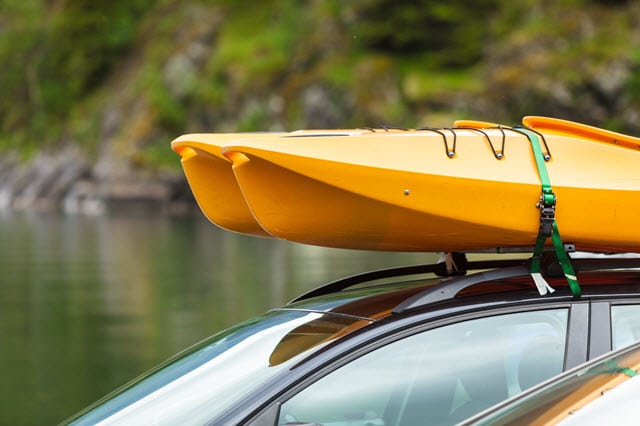
Of course, you must make sure the kayak is properly secured or it will be a safety hazard for you and others when you’re on the road.
There are certain tools you can use for securing a kayak to your vehicle if you don’t have a kayak rack. Combine these tools to keep your kayak secure against your vehicle during transportation.
Can You Haul a Kayak Without a Roof Rack?
Yes, as I touched on earlier, you can haul a kayak without having a roof rack on your car. There are several different approaches, including simple tools like:
Or you can buy a kit like this one that has everything you need.
Use Pool Noodles to Transport Your Kayak
For this method, you will need pool noodles and ratchet straps, including tie-down straps. At least two pool noodles are usually needed, as well as two sets each of ratchet straps and tie-down straps.
Of course, the exact size and quantity of tools you need will vary by vehicle size.
Have these materials at hand? Here are the steps to set things up.
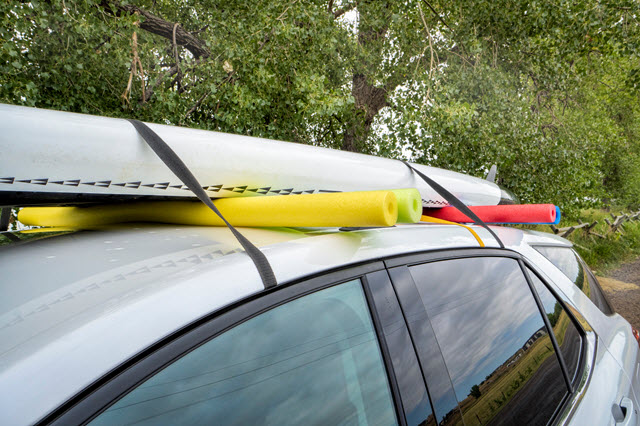
1. Position the Pool Noodles
Take your pool noodles and position them across the vehicle roof. Imagine them taking the place of a roof rack when deciding where to put them.
Put one of the pool noodles on the rear area of the vehicle and a second one on the front area.
If you feel you require more pool noodles to create more support, make sure you go ahead and do so. In many cases, however, two pool noodles are enough. It all depends on factors such as your vehicle type and size.
As you arrange the pool noodles, make sure they’re positioned so that they approximate a roof rack. In other words, they must have a certain distance between them. This is essential for keeping your kayak properly balanced.

When you use pool noodles, you will probably have to adjust their length by cutting them. Do this well in advance, ensuring you cut the pool noodles to the correct length to make them appropriate for the roof of your vehicle.
2. Put the Kayak on the Pool Noodles
Once you have your pool noodles appropriately in place, lift up your kayak. Place your kayak on the pool noodles, making sure they’re securely positioned. If you’re like most of us, you will probably need another person to help you with this.
That is because of the importance of keeping your kayak correctly balanced both as you’re maneuvering it and getting it positioned on your pool noodles.
Position your kayak so it’s upside down on the pool noodles, as this will optimize its stability. After you get your kayak positioned, you’re free to adjust the pool noodle positions in ensuring that they have the strength and stability necessary for keeping your kayak secure to your vehicle.
3. Put on the Straps
Once you’ve done what I outlined above, you have to secure your kayak (now correctly positioned on the pool noodles) with ratchet straps. This is absolutely essential, as these straps are necessary for stopping your kayak from getting detached from your vehicle as you drive.
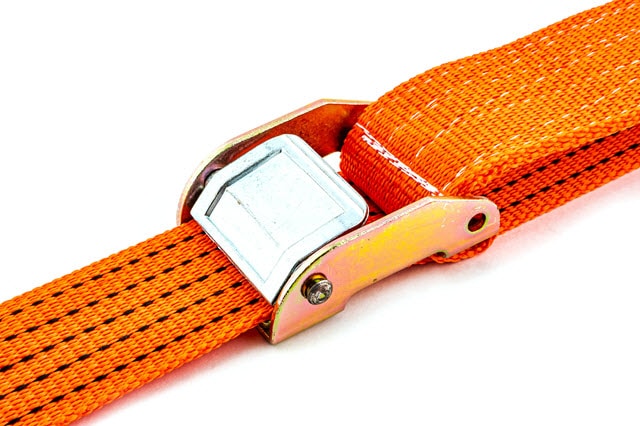
Make sure you correctly thread your straps over your kayak. There are certain steps involved in this. Let’s take a look at them below.
- Open the front doors of your vehicle.
- Put the ratchet straps over the vehicle’s body.
- Locate both ends of the strap.
- Position your strap so that the ends come together inside the vehicle.
- Ensure the strap buckle stays outside the vehicle.
- Get your strap tight and secure, twisting and pulling.
- Open the back door of your vehicle.
- Go through this process again for securing another strap through the vehicle’s back door.
4. Tie Down the Kayak Stern and Bow
This is essential for keeping your kayak safe and secure on your vehicle when you don’t have a roof rack. There are several different kinds of tie-down straps available on the market (I like these ones on Amazon).
You can get some parachute cord if you want to save some cash.
Take your tie-down strap and put it through the toggles or the back and front kayak carry handles. Then, get the strap ends properly secured to a spot where you can tie them down beneath your car. You will need a hook or carabiner to keep these secure.
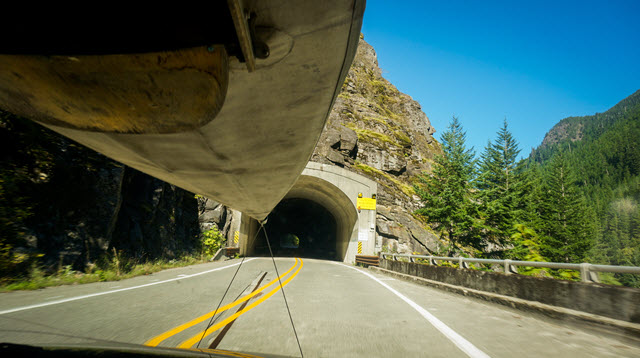
Find the tow points located underneath the front area of your vehicle. These are included in your vehicle’s design to allow for towing, but you can also use them for securing your front straps.
Best Ways to Transport a Kayak Without a Roof Rack
If you’re on a budget, using pool noodles and ratchet straps is the most economic option to transport your kayak. Many kayak owners find this to be the best way to transport a kayak without a roof rack, and prefer it to hauling kayaks inside an SUV or in the bed of your pickup.
Of course, you must make your kayak secure on your vehicle. After all, it is illegal to have an object on your car that isn’t properly secured.
It could fly off your car as you drive, potentially causing a serious accident.
How to Transport Two Kayaks Without a Roof Rack
Things get a bit trickier when you want to transport two kayaks without a roof rack. You’ll need three square stainless steel poles in addition to the pool noodles and ratchet straps I already mentioned. These ones on Amazon aren’t stainless, but you can spray them with Rustoleum to prevent rust if you can’t find them locally.
Ensure the poles are the right size so you can put them through the center of your pool noodles. You must use them to add stability and security. When cutting them to length, you’ll want to make sure your stainless steel poles aren’t so long that they’ll go past your vehicle’s side mirrors.
You Can Transport Your Kayak Safely Without a Roof Rack
So, now you know: it’s definitely possible to transport a kayak without a roof rack, and you can do so safely without damaging your car or putting your kayak at risk. The cheapest way to do it is to get some pool noodles, but you can also buy a kit designed specifically for kayaks as well (this is the one I recommend).
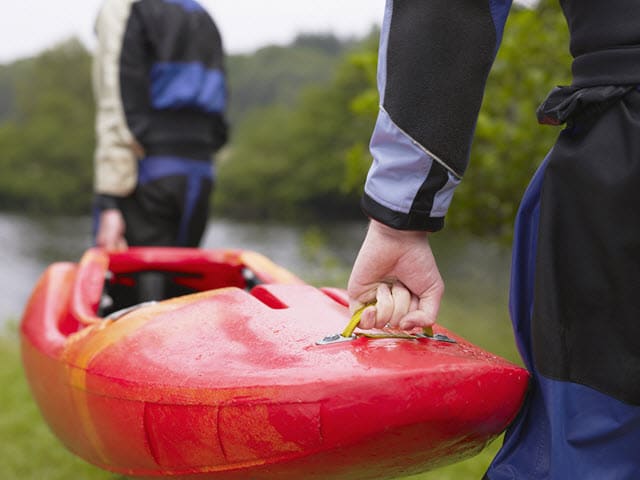
If you don’t yet have a kayak, you may be thinking an inflatable kayak might be more convenient for you. They’re not for everyone, and I suggest you learn about them right here before making your purchase.
Remember, it’s your responsibility as a driver to properly secure any items you have on the roof.


